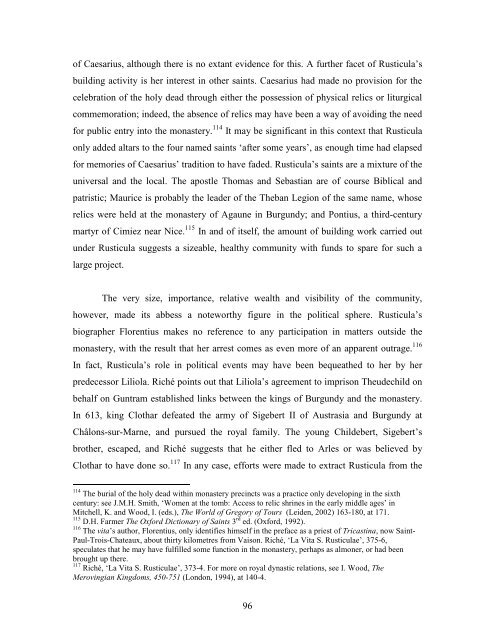Lindsay Rudge PhD Thesis - University of St Andrews
Lindsay Rudge PhD Thesis - University of St Andrews
Lindsay Rudge PhD Thesis - University of St Andrews
You also want an ePaper? Increase the reach of your titles
YUMPU automatically turns print PDFs into web optimized ePapers that Google loves.
<strong>of</strong> Caesarius, although there is no extant evidence for this. A further facet <strong>of</strong> Rusticula’s<br />
building activity is her interest in other saints. Caesarius had made no provision for the<br />
celebration <strong>of</strong> the holy dead through either the possession <strong>of</strong> physical relics or liturgical<br />
commemoration; indeed, the absence <strong>of</strong> relics may have been a way <strong>of</strong> avoiding the need<br />
for public entry into the monastery. 114 It may be significant in this context that Rusticula<br />
only added altars to the four named saints ‘after some years’, as enough time had elapsed<br />
for memories <strong>of</strong> Caesarius’ tradition to have faded. Rusticula’s saints are a mixture <strong>of</strong> the<br />
universal and the local. The apostle Thomas and Sebastian are <strong>of</strong> course Biblical and<br />
patristic; Maurice is probably the leader <strong>of</strong> the Theban Legion <strong>of</strong> the same name, whose<br />
relics were held at the monastery <strong>of</strong> Agaune in Burgundy; and Pontius, a third-century<br />
martyr <strong>of</strong> Cimiez near Nice. 115 In and <strong>of</strong> itself, the amount <strong>of</strong> building work carried out<br />
under Rusticula suggests a sizeable, healthy community with funds to spare for such a<br />
large project.<br />
The very size, importance, relative wealth and visibility <strong>of</strong> the community,<br />
however, made its abbess a noteworthy figure in the political sphere. Rusticula’s<br />
biographer Florentius makes no reference to any participation in matters outside the<br />
monastery, with the result that her arrest comes as even more <strong>of</strong> an apparent outrage. 116<br />
In fact, Rusticula’s role in political events may have been bequeathed to her by her<br />
predecessor Liliola. Riché points out that Liliola’s agreement to imprison Theudechild on<br />
behalf on Guntram established links between the kings <strong>of</strong> Burgundy and the monastery.<br />
In 613, king Clothar defeated the army <strong>of</strong> Sigebert II <strong>of</strong> Austrasia and Burgundy at<br />
Châlons-sur-Marne, and pursued the royal family. The young Childebert, Sigebert’s<br />
brother, escaped, and Riché suggests that he either fled to Arles or was believed by<br />
Clothar to have done so. 117 In any case, efforts were made to extract Rusticula from the<br />
114 The burial <strong>of</strong> the holy dead within monastery precincts was a practice only developing in the sixth<br />
century: see J.M.H. Smith, ‘Women at the tomb: Access to relic shrines in the early middle ages’ in<br />
Mitchell, K. and Wood, I. (eds.), The World <strong>of</strong> Gregory <strong>of</strong> Tours (Leiden, 2002) 163-180, at 171.<br />
115 D.H. Farmer The Oxford Dictionary <strong>of</strong> Saints 3 rd ed. (Oxford, 1992).<br />
116 The vita’s author, Florentius, only identifies himself in the preface as a priest <strong>of</strong> Tricastina, now Saint-<br />
Paul-Trois-Chateaux, about thirty kilometres from Vaison. Riché, ‘La Vita S. Rusticulae’, 375-6,<br />
speculates that he may have fulfilled some function in the monastery, perhaps as almoner, or had been<br />
brought up there.<br />
117 Riché, ‘La Vita S. Rusticulae’, 373-4. For more on royal dynastic relations, see I. Wood, The<br />
Merovingian Kingdoms, 450-751 (London, 1994), at 140-4.<br />
96

















